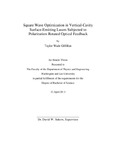Square Wave Optimization in Vertical-Cavity Surface-Emitting Lasers Subjected to Polarization-Rotated Optical Feedback (thesis)

View/
Author
Gilfillan, Taylor Wade
Subject
Washington and Lee University -- Honors in Physics
Lasers in physics -- Experiments
Square waves
Structural failures
Research
Mechanics, Applied
Metadata
Show full item recordDescription
Thesis; [FULL-TEXT FREELY AVAILABLE ONLINE] Taylor Wade Gilfillan is a member of the Class of 2013 of Washington and Lee University. I experimentally study the dynamics of vertical-cavity surface-emitting lasers (VCSELs) with polarization-rotated optical feedback. This type of semiconductor laser naturally emits linearly-polarized light and can elicit complex laser dynamics when subjected to optical feedback. Polarization-rotated optical feedback is created by a mirror placed a distance away from the laser (forming an external cavity) and the rotation of the feedback's polarization by 90° while in the cavity before being reinjected into the laser. Among the various complex dynamics that can possibly result from this form of feedback include chaotic behavior, polarization mono- and bistability, and square-waves. My experimental studies focus on the regularity of these square-waves. Noisy, square-wave-like polarization switchings are observed with periodicity slightly longer than twice the cavity round-trip delay time. I perform a separate parameter space study that indicates optimum operating conditions exist in feedback strength and pump current, for which the square waves are most regular. This conclusion is supported by careful examination of time series data, as well as statistical studies of the mean switching period.
Following my experimental results, I present the mathematical model used to numerically simulate a VCSEL known as the spin-flip model. This model specifically accounts for the rotated feedback present in our system and provides numerical results that further support our conclusion for square-wave optimization via mapping parameter space for pump current and birefringence of the semiconductor material. Taylor Wade Gilfillan